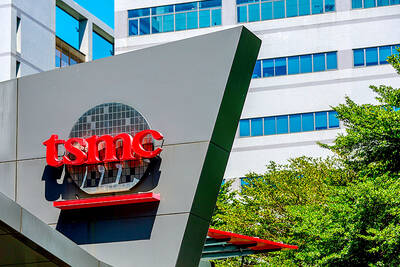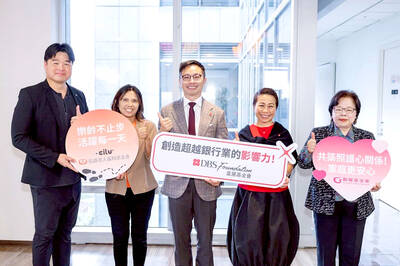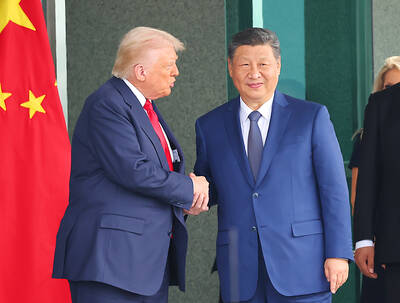Singapore's tallest condominium project will only be ready in 2009 at the earliest, but that has not stopped Asian buyers from joining the rush for one of the most prestigious addresses in town.
At least 30 percent of the buyers at the soft launch of Tower 2 of the Sail at Marina Bay were from the region, especially China, Hong Kong, Indonesia, Taiwan and India, according to developer City Developments Limited (CDL).
Fewer than 30 apartments remain unsold in the 430-unit Tower 2 where the price of a one-bedroom unit measuring 57-72m2 can set a buyer back by at least S$620,000 (US$366,864).

PHOTO: EPA
A bargain
But even that is seen as a bargain by some regional investors.
Property analysts said that the recovery in property prices here has lagged that of neighboring economies by 40 to 60 percent since the region was hit by the Severe Acute Respiratory Syndrome (SARS) health epidemic in 2003.
The SARS outbreak shook up the travel industry and also slowed down the economies of much of East Asia, including Singapore, six years after a regional financial crisis also hit the property sector.
"Our immediate neighbors have already run up so much [since SARS]," said Leslie Chua, the Singapore-based head of regional real estate intelligence for Jones Lang LaSalle.
`Looks attractive'
"If you look at places like Hong Kong, Bangkok and Kuala Lumpur, it's been trading very well. With all those markets running up so much, Singapore looks attractive," she added.
According to Chua's calculations, property prices in Hong Kong have shot up by 60 percent since the SARS outbreak, while in Kuala Lumpur, the increase is about 40 percent.
Prices in Shanghai, increasingly on the radar screens of investors, are up also by 40 percent, Chua said. By comparison, prices in Singapore rose by less than 10 percent over the same period, he said.
Education system
Apart from the attractive valuations, foreign buyers are also attracted to Singapore's status as a stable country and for those who are planning to send their kids to schools here, the education system, rated as one of the best in Asia, is a plus factor, analysts have said.
"We are perceived as a safe market so we will attract investors who are interested in putting their money here," Nicholas Mak, head of consultancy and research at Knight Frank property consultancy, said.
"There are some markets where it is easy to buy the property but difficult to exit," he said.
Useful investment
Mak said many Asian buyers are also planning to send their children here to study, so investing in a piece of property would be a useful investment.
A recent Jones Lang LaSalle study said that more than half of the buyers of the new residential projects in the September quarter were foreigners who went mostly for the high-end units.
According to the study, the prices of top-tier apartments at the end of June were still about 32 percent below their peak just before the 1997 Asian financial crisis.
"Singapore's luxury residential prices have remained stable in the past few years, lagging behind other major Asian cities like Shanghai, Beijing, Hong Kong and Bangkok," the study said.
Mini-boom
Things have begun to stir this year and share prices of property companies in Singapore have enjoyed a mini-boom after the government announced in July new measures to boost the market, including a relaxation of certain rules to allow foreign ownership.
The share price of Keppel Land, for example, is up almost 40 percent since the announcement of the government's pro-property measures while Wing Tai Holdings is 23 percent higher.
CDL's share price is up almost 1.7 percent.
Upmarket apartments
Prices of upmarket apartments and condominiums rose 4.1 percent in the July-September period to an average S$1,020 per square foot.
This is double the 2.1 percent rise in the second quarter.
Preliminary government figures showed housing prices rose 1.1 percent in the third quarter, the biggest quarterly increase in five years.
So overwhelming is the response to the CDL project, made up of two sail-shaped towers with the taller 70-story Tower 1 rising to 245m, that CDL is considering canceling the public launch of the 63-story Tower 2 block.
Last year's sales launch of the 70-story Tower 1 was equally popular with foreign investors, making up 40 percent of the buyers according to CDL, which is the joint developer with AIG Global Real Estate Investment Corp.

RUN IT BACK: A succesful first project working with hyperscalers to design chips encouraged MediaTek to start a second project, aiming to hit stride in 2028 MediaTek Inc (聯發科), the world’s biggest smartphone chip supplier, yesterday said it is engaging a second hyperscaler to help design artificial intelligence (AI) accelerators used in data centers following a similar project expected to generate revenue streams soon. The first AI accelerator project is to bring in US$1 billion revenue next year and several billion US dollars more in 2027, MediaTek chief executive officer Rick Tsai (蔡力行) told a virtual investor conference yesterday. The second AI accelerator project is expected to contribute to revenue beginning in 2028, Tsai said. MediaTek yesterday raised its revenue forecast for the global AI accelerator used

Taiwan Semiconductor Manufacturing Co (TSMC, 台積電) has secured three construction permits for its plan to build a state-of-the-art A14 wafer fab in Taichung, and is likely to start construction soon, the Central Taiwan Science Park Bureau said yesterday. Speaking with CNA, Wang Chun-chieh (王俊傑), deputy director general of the science park bureau, said the world’s largest contract chipmaker has received three construction permits — one to build a fab to roll out sophisticated chips, another to build a central utility plant to provide water and electricity for the facility and the other to build three office buildings. With the three permits, TSMC

The DBS Foundation yesterday announced the launch of two flagship programs, “Silver Motion” and “Happier Caregiver, Healthier Seniors,” in partnership with CCILU Ltd, Hondao Senior Citizens’ Welfare Foundation and the Garden of Hope Foundation to help Taiwan face the challenges of a rapidly aging population. The foundation said it would invest S$4.91 million (US$3.8 million) over three years to foster inclusion and resilience in an aging society. “Aging may bring challenges, but it also brings opportunities. With many Asian markets rapidly becoming super-aged, the DBS Foundation is working with a regional ecosystem of like-minded partners across the private, public and people sectors

TEMPORARY TRUCE: China has made concessions to ease rare earth trade controls, among others, while Washington holds fire on a 100% tariff on all Chinese goods China is effectively suspending implementation of additional export controls on rare earth metals and terminating investigations targeting US companies in the semiconductor supply chain, the White House announced. The White House on Saturday issued a fact sheet outlining some details of the trade pact agreed to earlier in the week by US President Donald Trump and Chinese President Xi Jinping (習近平) that aimed to ease tensions between the world’s two largest economies. Under the deal, China is to issue general licenses valid for exports of rare earths, gallium, germanium, antimony and graphite “for the benefit of US end users and their suppliers